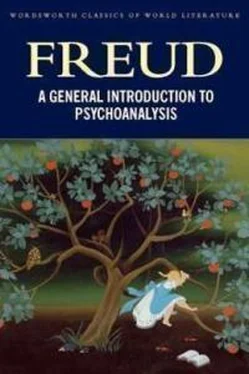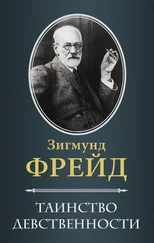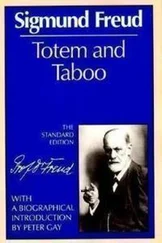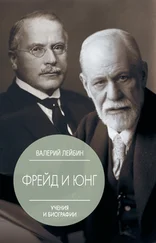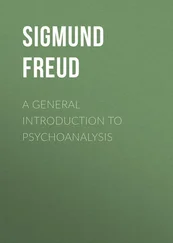Let us sum up what our plunge into child psychology has given us toward the understanding of the dream. We found not only that the materials of forgotten childhood experiences are accessible to the dream, but we saw also that the psychic life of children, with all its peculiarities, its egoism, its incestuous love–choice, etc., continues, for the purposes of the dream, in the unconscious, and that the dream nightly leads us back to this infantile stage. Thus it becomes more certain that the unconscious in our psychic life is the infantile . The estranging impression that there is so much evil in man, begins to weaken. This frightful evil is simply the original, primitive, infantile side of psychic life, which we may find in action in children, which we overlook partly because of the slightness of its dimensions, partly because it is lightly considered, since we demand no ethical heights of the child. Since the dream regresses to this stage, it seems to have made apparent the evil that lies in us. But it is only a deceptive appearance by which we have allowed ourselves to be frightened. We are not so evil as we might suspect from the interpretation of dreams.
If the evil impulses of the dream are merely infantilism, a return to the beginnings of our ethical development, since the dream simply makes children of us again in thinking and in feeling, we need not be ashamed of these evil dreams if we are reasonable. But being reasonable is only a part of psychic life. Many things are taking place there that are not reasonable, and so it happens that we are ashamed of such dreams, and unreasonably. We turn them over to the dream–censorship, are ashamed and angry if one of these dreams has in some unusual manner succeeded in penetrating into consciousness in an undistorted form, so that we must recognize it—in fact, we are at times just as ashamed of the distorted dream as we would be if we understood it. Just think of the scandalized opinion of the fine old lady about her uninterpreted dream of "services of love." The problem is not yet solved, and it is still possible that upon further study of the evil in the dream we shall come to some other decision and arrive at another valuation of human nature.
As a result of the whole investigation we grasp two facts, which, however, disclose only the beginnings of new riddles, new doubts. First: the regression of dream–work is not only formal, it is also of greater import. It not only translates our thoughts into a primitive form of expression, but it reawakens the peculiarities of our primitive psychic life, the ancient predominance of the ego, the earliest impulses of our sexual life, even our old intellectual property, if we may consider the symbolic relations as such. And second: We must accredit all these infantilisms which once were governing, and solely governing, to the unconscious, about which our ideas now change and are broadened. Unconscious is no longer a name for what is at that time latent, the unconscious is an especial psychic realm with wish–impulses of its own, with its own method of expression and with a psychic mechanism peculiar to itself, all of which ordinarily are not in force. But the latent dream–thoughts, which we have solved by means of the dream–interpretation, are not of this realm. They are much more nearly the same as any we may have thought in our waking hours. Still they are unconscious; how does one solve this contradiction? We begin to see that a distinction must be made. Something that originates in our conscious life, and that shares its characteristics—we call it the day–remnants—combines in the dream–fabrication with something else out of the realm of the unconscious. Between these two parts the dream–work completes itself. The influencing of the day–remnants by the unconscious necessitates regression. This is the deepest insight into the nature of the dream that we are able to attain without having searched through further psychic realms. The time will soon come, however, when we shall clothe the unconscious character of the latent dream–thought with another name, which shall differentiate it from the unconscious out of the realm of the infantile.
We may, to be sure, propound the question: what forces the psychological activity during sleep to such regression? Why do not the sleep disturbing psychic stimuli do the job without it? And if they must, because of the dream censorship, disguise themselves through old forms of expression which are no longer comprehensible, what is the use of giving new life to old, long–outgrown psychic stimuli, wishes and character types, that is, why the material regression in addition to the formal? The only satisfactory answer would be this, that only in this manner can a dream be built up, that dynamically the dream–stimulus can be satisfied only in this way. But for the time being we have no right to give such an answer.
Fourteenth Lecture
The Dream - Wish Fulfillment
May I bring to your attention once more the ground we have already covered? How, when we met with dream distortion in the application of our technique, we decided to leave it alone for the time being, and set out to obtain decisive information about the nature of the dream by way of infantile dreams? How, then, armed with the results of this investigation, we attacked dream distortion directly and, I trust, in some measure overcame it? But we must remind ourselves that the results we found along the one way and along the other do not fit together as well as might be. It is now our task to put these two results together and balance them against one another.
From both sources we have seen that the dream–work consists essentially in the transposition of thoughts into an hallucinatory experience. How that can take place is puzzling enough, but it is a problem of general psychology with which we shall not busy ourselves here. We have learned from the dreams of children that the purpose of the dream–work is the satisfaction of one of the sleep–disturbing psychic stimuli by means of a wish fulfillment. We were unable to make a similar statement concerning distorted dreams, until we knew how to interpret them. But from the very beginning we expected to be able to bring the distorted dreams under the same viewpoint as the infantile. The earliest fulfillment of this expectation led us to believe that as a matter of fact all dreams are the dreams of children and that they all work with infantile materials, through childish psychic stimuli and mechanics. Since we consider that we have conquered dream–distortion, we must continue the investigation to see whether our hypothesis of wish–fulfillment holds good for distorted dreams also.
We very recently subjected a number of dreams to interpretation, but left wish–fulfillment entirely out of consideration. I am convinced that the question again and again occurred to you: "What about wish–fulfillment, which ostensibly is the goal of dream–work?" This question is important. It was, in fact, the question of our lay–critics. As you know, humanity has an instinctive antagonism toward intellectual novelties. The expression of such a novelty should immediately be reduced to its narrowest limits, if possible, comprised in a commonplace phrase. Wish–fulfillment has become that phrase for the new dream–science. The layman asks: "Where is the wish–fulfillment?" Immediately, upon having heard that the dream is supposed to be a wish–fulfillment, and indeed, by the very asking of the question, he answers it with a denial. He is at once reminded of countless dream–experiences of his own, where his aversion to the dream was enormous, so that the proposition of psychoanalytic dream–science seems very improbable to him. It is a simple matter to answer the layman that wish–fulfillment cannot be apparent in distorted dreams, but must be sought out, so that it is not recognized until the dream is interpreted. We know, too, that the wishes in these distorted dreams are prohibited wishes, are wishes rejected by the censor and that their existence lit the very cause of the dream distortion and the reason for the intrusion of the dream censor. But it is hard to convince the lay–critic that one may not seek the wish–fulfillment in the dream before the dream has been interpreted. This is continually forgotten. His sceptical attitude toward the theory of wish–fulfillment is really nothing more than a consequence of dream–censorship, a substitute and a result of the denial of this censored dream–wish.
Читать дальше
